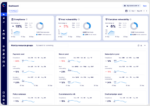
The cloud is not a yes/no question – but, if it were, the answer is yes. Yes, cloud resources can help companies to modernize their systems and gain access to capabilities they never had before.
Unless you work for a Fortune 100 company that has made considerable investments in building cloud-like data centers, you can’t hope to match the economies of scale and DevOps expertise that exist within companies such as Amazon Web Services or Microsoft Azure. Between them, they have spent many billions creating over 200 data centers across over 100+ countries and regions. These are resources you could never hope to field on your own.
When I was leading IT at a previous company, one of the benefits we got from moving applications to the cloud is that we could begin to apply machine learning techniques to analyzing the activities of field services technicians so we could deploy them more effectively. That’s not something we would have tackled without access to cloud tools that made it relatively easy to get started without a huge investment. But neither did it require a wholesale migration.
Strategic use of the cloud allows you to begin asking questions and creating solutions that otherwise would have lingered forever out of reach because of cost and technical barriers. Datamation makes the same point in its report, Cloud Computing 2019: Using the Cloud for Competitive Advantage.
How to take advantage of the cloud is the multi-million dollar question. Get stampeded into making the wrong decision, and you could wind up throwing away millions. Do it right, and the payoff can be immense.
The catch is all cloud services are not alike. There are important distinctions between paying to access a cloud-based application, versus a cloud platform for building applications, or basic infrastructure services such as storage and computing power. Some applications lend themselves to the cloud better than others, which is why software-as-a-service (SaaS) has become dominant in categories like collaboration and CRM.
The tougher questions tend to come with regard to ERPs – systems that take a lot of blood, sweat, and tears to implement and perfect, ultimately becoming the “heart and brain” of the organization. Moving to a SaaS ERP, even from the same vendor, means potentially throwing away years of work on customizations and integrations that may not meet the vendor’s definition of “best practices.”
The cynic in me says the “best practice” they’re probably most interested in is getting you to buy more of whatever they’re selling. Consider what Oracle’s co-CEO Mark Hurd told financial analysts: “When a customer who is on-prem paying us support moves to the cloud, they pay us more money. They don’t pay us one to one, they don’t pay us two to one, they pay us more like three to one. In some cases more than three to one.”
Worse, you may also find that some of your most business-critical ERP applications, such as shop floor automation and supply chain management, do not have equally capable SaaS equivalents.
Some companies have concluded their ERP implementations are such a mess that they should start over in the cloud. Even then, we typically see them phasing in SaaS ERP but continuing to rely on their established platform during a transition that could take years. Many of our clients are satisfied with their current ERP and would rather invest their time and talent in other, revenue-producing applications.
Even those who don’t think their organization needs a heart transplant may conclude it does need to build new muscles. They can begin running their existing ERPs (customizations and all) on cloud infrastructure and gradually weave in other cloud services.
I disagree with those who disparage this “lift and shift” strategy for moving an existing ERP to cloud hosting – even if the application itself remains more or less unchanged. For example, one of our clients achieved better performance with cloud hosting its Oracle EBS system, partly because the cloud provider set them up on its latest and greatest server hardware. Now they no longer worry about replacing and refreshing hardware, and achieving high availability and disaster recovery (a capability they never had before) is just a matter of taking advantage of the cloud provider’s distributed architecture.
Certainly, there has been a pivot in the corporate world. A few years ago, you could express doubt about embracing the cloud, and company leaders would nod approvingly at your caution. Today, IT leaders who are not prepared to go all-in on the cloud as your modernization strategy must be prepared to explain themselves because “everybody knows” the cloud is the future.
Why the Rush to the Cloud?
There is a bit of “airline magazine management” going on here. That’s the scenario where your CEO was reading about the wonders of the cloud on his last flight, so now that’s the strategy. I hope that’s not your CEO – or, if it is, that you can persuade him of the need to take a methodical approach.
It is not true that everything in the cloud is automatically better and cheaper and more innovative. While great efficiencies are possible, it’s also easy to overprovision unneeded capacity or allow unmonitored services to balloon out of control because you’ve configured them to scale up automatically. You can subscribe to SaaS applications that lock you into using that vendor forever after, or that make it very difficult to switch. I have been to that movie and wish I could have left before it ended badly.
Even for cloud products that have positive-sounding words like “autonomous” or “elastic” baked into their names, success is not automatic. You must make sure these services aren’t stretching you in a direction you don’t want to go.
Once you move an ERP, or any enterprise database application, into the cloud, the next logical step is to start taking advantage of all the cloud services for artificial intelligence, machine learning, visualization, analytics and the Internet of Things where cloud providers are innovating at a rapid pace.
Taking advantage of advanced cloud services becomes much more practical when your applications and data are already there. That means getting your applications not just into “the cloud” but into the right cloud. Microsoft, Amazon and Google are investing billions in creating next-generation data management tools – and you can take advantage of them for pennies on the dollar. No longer limited by the need to order, install and configure servers, you can deploy cutting-edge data services in minutes.
You do not have to move everything to the cloud, and you should not rush anything. Pick your spots and start taking advantage of the cloud technologies with the potential to make the greatest business impact.








